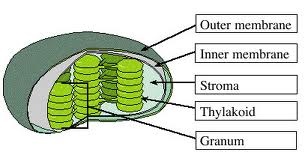Chlorophyll is a complex organic compound. It absorbs mainly blue and red protein of sunlight. The green portion is mainly effected therefore chlorophyll appears green. Cholophyll captures a portion of the visible spectrum of sun light and converts it into chemical energy for the formation of carbohydrates. Chlorophyll is present in green plastids of plants called chloroplasts.
Structure of chloroplast
A chloroplast consist of three components; An outer most covering (envelop), grana ( singular granum) and stroma. The outer most covering ( envelop ) of the chloroplast is formed by a double membrane structure that encloses the grana and stroma.
Grana :
A granum consist of many flattened fluid filled membranous sacs or discs called thylakoids which from stacks and resemble a pile of coins. There are many grana which are interconnected by lamellae (layer) called intergrana. The grana are visible under the light microscope as grains. Chlorophyll and other photosynthetic pigments (carotenoids) are present within the membranes of thylakoids. These membranes are the sites of light trapping reaction (light reaction) of photosynthesis.

Stroma :
The double membrane envelop of the chloroplast surrounds a large central space called stroma. The stroma contains enzymes (proteins) rich gel-like solution called matrix where light independent reaction (dark reaction) of photosynthesis takes place.
_fa_rszd.jpg)
There are many types of chlorophyll i.e Chlorophyll a,b,c,d,e and bacteriochlorophyll. Chlorophyll "a" is most abundant and most important photosynthetic pigment. It is found in all green plants except bacteria. It exists in several forms depending on its arrangement in the membrane. Chlorophyll "b" is found in all higher plants (Embryophytes) and green algae. Chlorophyll "c" , "d" and "e" are found in various groups of algae. Bacterio- chlorophyll is found in bacteria.



